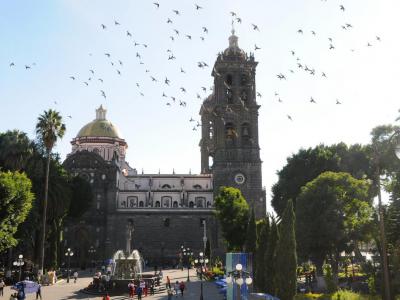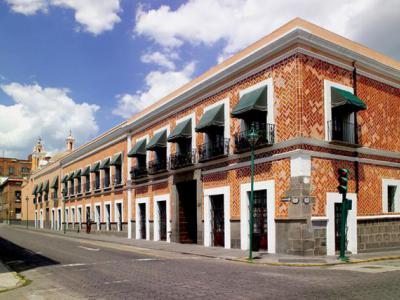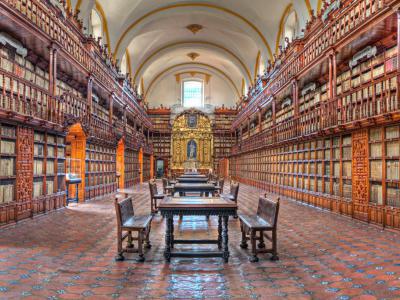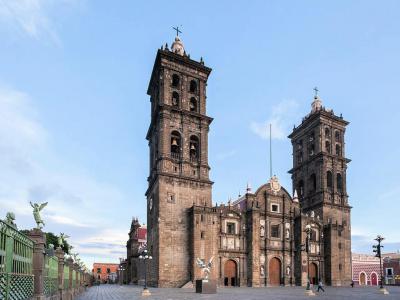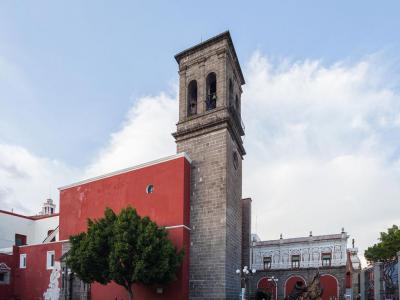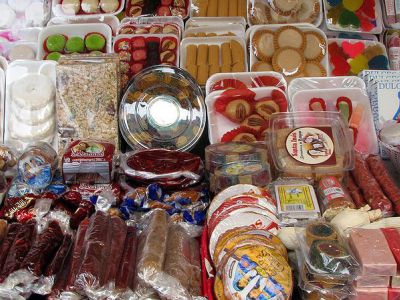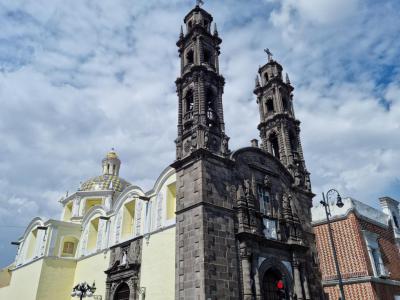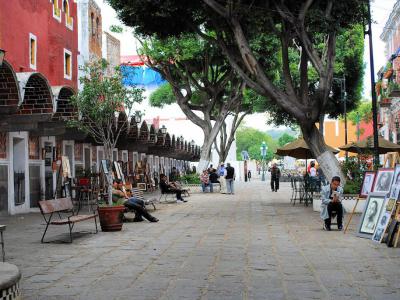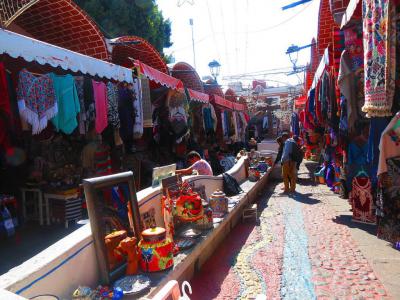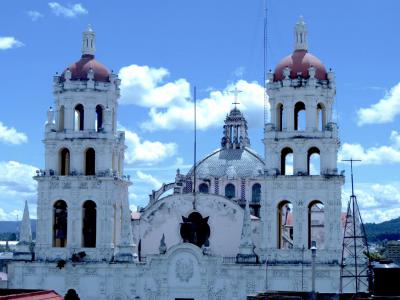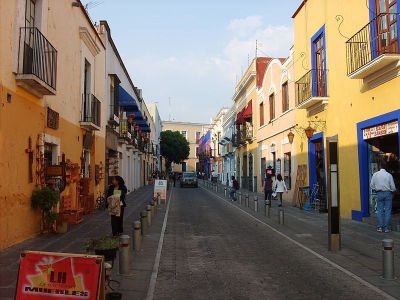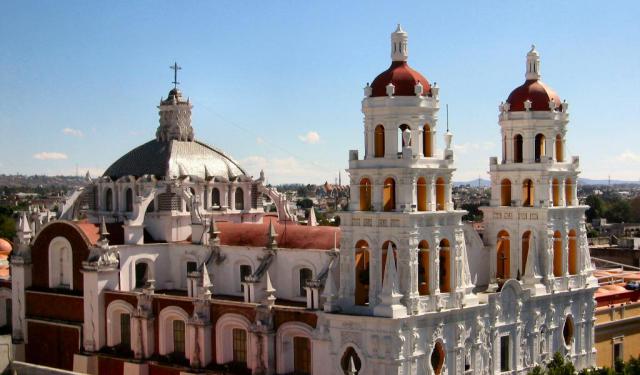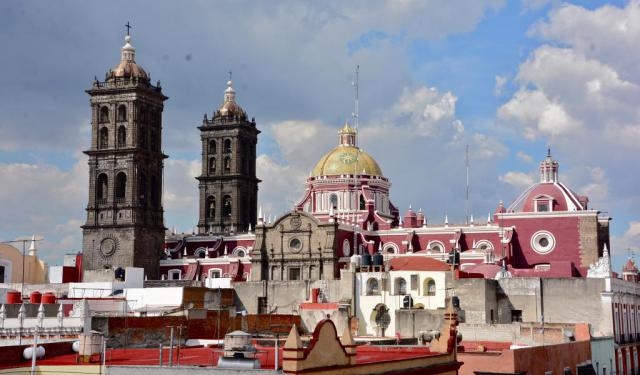
Puebla Introduction Walking Tour (Self Guided), Puebla
The city of Puebla is the capital of the state of Puebla and the fourth largest city in Mexico. It was founded in 1531 in an uninhabited area between two indigenous settlements of the time, Tlaxcala and Cholula. The area used to be called Cuetlaxcoapan, which means "where serpents change their skin".
Spanish conquistador Hernán Cortés occupied the Puebla region in 1519, killing most of the natives and resulting the fall of the Aztec empire. However, rather than building on top of an existing city, Spanish conquistadors chose to build Puebla in a different location. The new city of Puebla was the first Spanish-built city in central Mexico not founded on the ruins of a conquered settlement.
Puebla is famous for its food, artistry and architecture. Talavera pottery originates from Puebla. The well-known traditional Mexican dish, mole poblano, was created in Puebla. Visitors can try authentic dishes made with traditional Mexican mole when they stop to eat in the Alley of the Frogs, Sweets Street or the Parian Crafts Market.
Likewise, history lovers will see architectural styles that are known as some of the best examples of Mexican Baroque. This is particularly seen in the Rosario Chapel, which has been called by some the eighth wonder of the world.
Due to its important place in the history and culture of Mexico, Puebla's historic center was named a UNESCO World Heritage Site in 1987.
In its early days, Puebla was primarily known for agriculture owing to the region’s rich volcanic soils. Today, the city's economics mostly focus on industry and manufacturing. For example, Puebla is home to the world's largest Volkswagen factory outside of Germany.
The historic center of the city remains a popular tourist destination. Visitors will see the masterful architecture in the mansions and churches that surround Zocalo Plaza. Among these structures are the Palafoxiana Library, the Puebla Cathedral and the Temple of the Holy Spirit. It is worthwhile to step inside the Palafoxiana Library to see the oldest library in the Americas.
The Amparo Museum is an important spot for anyone who wants to know more about Puebla and see early examples of colonial-era buildings. Held in structures that once hosted a hospital and a private home, the museum displays art and artifacts from pre-Columbian, colonial and modern history of the Puebla region.
Take this self-guided walking tour to explore the most beautiful places in Puebla, Mexico.
Spanish conquistador Hernán Cortés occupied the Puebla region in 1519, killing most of the natives and resulting the fall of the Aztec empire. However, rather than building on top of an existing city, Spanish conquistadors chose to build Puebla in a different location. The new city of Puebla was the first Spanish-built city in central Mexico not founded on the ruins of a conquered settlement.
Puebla is famous for its food, artistry and architecture. Talavera pottery originates from Puebla. The well-known traditional Mexican dish, mole poblano, was created in Puebla. Visitors can try authentic dishes made with traditional Mexican mole when they stop to eat in the Alley of the Frogs, Sweets Street or the Parian Crafts Market.
Likewise, history lovers will see architectural styles that are known as some of the best examples of Mexican Baroque. This is particularly seen in the Rosario Chapel, which has been called by some the eighth wonder of the world.
Due to its important place in the history and culture of Mexico, Puebla's historic center was named a UNESCO World Heritage Site in 1987.
In its early days, Puebla was primarily known for agriculture owing to the region’s rich volcanic soils. Today, the city's economics mostly focus on industry and manufacturing. For example, Puebla is home to the world's largest Volkswagen factory outside of Germany.
The historic center of the city remains a popular tourist destination. Visitors will see the masterful architecture in the mansions and churches that surround Zocalo Plaza. Among these structures are the Palafoxiana Library, the Puebla Cathedral and the Temple of the Holy Spirit. It is worthwhile to step inside the Palafoxiana Library to see the oldest library in the Americas.
The Amparo Museum is an important spot for anyone who wants to know more about Puebla and see early examples of colonial-era buildings. Held in structures that once hosted a hospital and a private home, the museum displays art and artifacts from pre-Columbian, colonial and modern history of the Puebla region.
Take this self-guided walking tour to explore the most beautiful places in Puebla, Mexico.
How it works: Download the app "GPSmyCity: Walks in 1K+ Cities" from Apple App Store or Google Play Store to your mobile phone or tablet. The app turns your mobile device into a personal tour guide and its built-in GPS navigation functions guide you from one tour stop to next. The app works offline, so no data plan is needed when traveling abroad.
Puebla Introduction Walking Tour Map
Guide Name: Puebla Introduction Walking Tour
Guide Location: Mexico » Puebla (See other walking tours in Puebla)
Guide Type: Self-guided Walking Tour (Sightseeing)
# of Attractions: 11
Tour Duration: 2 Hour(s)
Travel Distance: 2.5 Km or 1.6 Miles
Author: HelenF
Sight(s) Featured in This Guide:
Guide Location: Mexico » Puebla (See other walking tours in Puebla)
Guide Type: Self-guided Walking Tour (Sightseeing)
# of Attractions: 11
Tour Duration: 2 Hour(s)
Travel Distance: 2.5 Km or 1.6 Miles
Author: HelenF
Sight(s) Featured in This Guide:
- Zocalo Plaza and San Miguel Fountain
- Amparo Museum
- Biblioteca Palafoxiana (Palafoxiana Library)
- Catedral de Puebla (Puebla Cathedral)
- Convento de Santo Domingo (St Domingo Convent and Rosario Chapel)
- Calle de los Dulce (Sweets Street)
- Iglesia de San Cristóbal (Church of San Cristóbal)
- Barrio del Artistas (Artist Quarter)
- Mercado de Artesanias "El Parián" (Parian Crafts Market)
- Templo de la Compañia de Jesús (Temple of the Holy Spirit)
- Callejón de los Sapos (Alley of the Frogs)
1) Zocalo Plaza and San Miguel Fountain (must see)
Zocalo Plaza is the main square in the center of Puebla. It is considered to be the cultural and political center of the city. It was also the source of drinking water through the mid-16th century. Zocalo, which means plinth or pedestal, was the first block created in Puebla. The remainder of the city was built out from Zocalo in a checkerboard pattern. The Zocalo and surrounding blocks have played a central role in the city's planning and geography for over 500 years.
Zocalo Plaza has long been a location for entertainment and celebrations. Bullfights were regular contests in the square until they ended in 1722. It was also the primary market of Puebla through the end of the 18th century.
Buildings around Zocalo Plaza include the Colorado House Museum, the Cathedral of Saint Mary of the Assumption, the City Hall, and numerous shopping venues. The square is known for its public art, including four statues of muses installed at each corner of the plaza, the Monument to the Siege of Puebla, the Kiosko sculpture by Jan Hendrix, and Puebla de los Angeles.
Zocalo Plaza is also known as the location of the San Miguel Fountain. San Miguel was the main patron of Puebla city. The composition of the fountain features waterfalls on a wide cup, supported by four life-size angels. The statue of the San Miguel stays on a stone column in the center of the structure.
The San Miguel Fountain is one of the historical monuments most seen by locals and tourists because it is located right in the center of Zocalo Plaza. Despite its popularity, few know the history of the fountain. It was the first fountain in the Zocalo and the center of the water supply in the city.
The San Miguel Fountain was designed by one of the most famous architects in the country during the 18th century, Antonio Santa Maria Inchaurregui, and carved by stone carving masters Anselmo Martínez and José Francisco Rabanillo. The fountain was inaugurated on June 23, 1777.
Zocalo Plaza has long been a location for entertainment and celebrations. Bullfights were regular contests in the square until they ended in 1722. It was also the primary market of Puebla through the end of the 18th century.
Buildings around Zocalo Plaza include the Colorado House Museum, the Cathedral of Saint Mary of the Assumption, the City Hall, and numerous shopping venues. The square is known for its public art, including four statues of muses installed at each corner of the plaza, the Monument to the Siege of Puebla, the Kiosko sculpture by Jan Hendrix, and Puebla de los Angeles.
Zocalo Plaza is also known as the location of the San Miguel Fountain. San Miguel was the main patron of Puebla city. The composition of the fountain features waterfalls on a wide cup, supported by four life-size angels. The statue of the San Miguel stays on a stone column in the center of the structure.
The San Miguel Fountain is one of the historical monuments most seen by locals and tourists because it is located right in the center of Zocalo Plaza. Despite its popularity, few know the history of the fountain. It was the first fountain in the Zocalo and the center of the water supply in the city.
The San Miguel Fountain was designed by one of the most famous architects in the country during the 18th century, Antonio Santa Maria Inchaurregui, and carved by stone carving masters Anselmo Martínez and José Francisco Rabanillo. The fountain was inaugurated on June 23, 1777.
2) Amparo Museum (must see)
The Amparo Museum is one of the most important history museums in Mexico. It was founded and sponsored by the Amparo Foundation in 1991.
The museum is housed in two Colonial-style buildings. One of the buildings is the former Hospital of Our Lady and San Juan de Letran, built in the 17th century. It later became a college for women before it was used for the Amparo Museum. This building holds most of the exhibits from the historical collection.
The museum's collection follows the development of Mexico throughout its history. Pieces in the collection date from 2,500 BC to the present day. Items include figures, altars, sculptures, and monuments from civilizations like Maya, Olmec, Mixtec, Aztecs, and Huastec.
The second building, added in the 18th century, was used as part of the hospital but later became a private home. It has been remodeled to display how the houses would have looked throughout the colonization of Mexico.
The Amparo Museum also hosts temporary exhibits by national and international artists. It presents conferences, seminars, concerts, and workshops to support education, research, and the creative arts. There is no charge to enter the museum, which is open from 10 AM to 6 PM. Amparo Museum is closed on Tuesdays.
The museum is housed in two Colonial-style buildings. One of the buildings is the former Hospital of Our Lady and San Juan de Letran, built in the 17th century. It later became a college for women before it was used for the Amparo Museum. This building holds most of the exhibits from the historical collection.
The museum's collection follows the development of Mexico throughout its history. Pieces in the collection date from 2,500 BC to the present day. Items include figures, altars, sculptures, and monuments from civilizations like Maya, Olmec, Mixtec, Aztecs, and Huastec.
The second building, added in the 18th century, was used as part of the hospital but later became a private home. It has been remodeled to display how the houses would have looked throughout the colonization of Mexico.
The Amparo Museum also hosts temporary exhibits by national and international artists. It presents conferences, seminars, concerts, and workshops to support education, research, and the creative arts. There is no charge to enter the museum, which is open from 10 AM to 6 PM. Amparo Museum is closed on Tuesdays.
3) Biblioteca Palafoxiana (Palafoxiana Library) (must see)
The Palafoxiana Library (Biblioteca Palafoxiana) is a historic library in Puebla City, Mexico. Established in 1646, it holds over 45,000 books and manuscripts, ranging from the 15th to the 20th century. It is the first and oldest public library in the Americas.
The library was named for Juan de Palafox y Mendoza, Bishop of Puebla. Palafox y Mendoza donated 5,000 volumes to the College of San Juan to create a library.
The building that holds the Library Palafoxiana was completed in 1773 at the behest of Francisco Fabian y Fuero, a Spanish Roman Catholic Bishop. In addition to Palafox y Mendoza's donation, Fabian y Fuero donated his books and those of bishops Manuel Fernandez de Santa Cruz and Francisco Pablo Vazquez. In addition, books confiscated from Jesuits and religious schools were placed in the library. The oldest text in the library is "The Nuremberg Chronicle," one of the best-documented early printed books written by Hartmann Schedel in 1493.
The Palafoxiana Library is listed on UNESCO's Memory of the World Register. The library is open Tuesday through Sunday from 10 AM to 6 PM.
The library was named for Juan de Palafox y Mendoza, Bishop of Puebla. Palafox y Mendoza donated 5,000 volumes to the College of San Juan to create a library.
The building that holds the Library Palafoxiana was completed in 1773 at the behest of Francisco Fabian y Fuero, a Spanish Roman Catholic Bishop. In addition to Palafox y Mendoza's donation, Fabian y Fuero donated his books and those of bishops Manuel Fernandez de Santa Cruz and Francisco Pablo Vazquez. In addition, books confiscated from Jesuits and religious schools were placed in the library. The oldest text in the library is "The Nuremberg Chronicle," one of the best-documented early printed books written by Hartmann Schedel in 1493.
The Palafoxiana Library is listed on UNESCO's Memory of the World Register. The library is open Tuesday through Sunday from 10 AM to 6 PM.
4) Catedral de Puebla (Puebla Cathedral) (must see)
Puebla Cathedral (Catedral de Puebla) is the episcopal see of the Archdiocese of Puebla. The Cathedral was founded by King Philip II of Spain, and its construction began in 1575. It was consecrated in 1649 though it remained unfinished. The cathedral is also known as the Basilica Cathedral of Puebla or the Cathedral of Our Lady of the Immaculate Conception.
The Cathedral also functions as a museum. It holds multiple works of art, including paintings, sculptures, carpentry, and jewelry. Items on display include sacred vessels and crosses made with gold and encrusted with precious gems. Its historical archive has documents dating back to the founding of the city.
The first architect of Puebla Cathedral was Francisco Becerra. The indigenous Cholula and Tlaxcala participated in the construction of the Cathedral. In the mid-17th century, the architect Juan Gomez de Trasmonte took over the plans. Gómez de Trasmonte, who had served as Major Master of the Mexico City Metropolitan Cathedral, adapted the project, giving it a more classical appearance and a basilica plan.
Bishop Juan de Palafox y Mendoza joined the Cathedral around 1640 and ordered construction work to be finished. He used his own wealth and conducted fundraising in the form of tithes. The facade of the edifice was completed in 1664.
The north tower, also called Old Tower, was added in 1678. It is the only bell tower with ten bells in total. The most famous is the Bell Maria (Campana María,) weighing more than nine tons. The south tower was added in 1731. Both towers are about 230 feet high, being at the time, the highest in the American colonies.
Five daily masses are celebrated Monday through Saturday. The Cathedral celebrates 10 masses on Sundays. All guests are welcome.
Puebla Cathedral is declared a World Heritage Site by UNESCO.
The Cathedral also functions as a museum. It holds multiple works of art, including paintings, sculptures, carpentry, and jewelry. Items on display include sacred vessels and crosses made with gold and encrusted with precious gems. Its historical archive has documents dating back to the founding of the city.
The first architect of Puebla Cathedral was Francisco Becerra. The indigenous Cholula and Tlaxcala participated in the construction of the Cathedral. In the mid-17th century, the architect Juan Gomez de Trasmonte took over the plans. Gómez de Trasmonte, who had served as Major Master of the Mexico City Metropolitan Cathedral, adapted the project, giving it a more classical appearance and a basilica plan.
Bishop Juan de Palafox y Mendoza joined the Cathedral around 1640 and ordered construction work to be finished. He used his own wealth and conducted fundraising in the form of tithes. The facade of the edifice was completed in 1664.
The north tower, also called Old Tower, was added in 1678. It is the only bell tower with ten bells in total. The most famous is the Bell Maria (Campana María,) weighing more than nine tons. The south tower was added in 1731. Both towers are about 230 feet high, being at the time, the highest in the American colonies.
Five daily masses are celebrated Monday through Saturday. The Cathedral celebrates 10 masses on Sundays. All guests are welcome.
Puebla Cathedral is declared a World Heritage Site by UNESCO.
5) Convento de Santo Domingo (St Domingo Convent and Rosario Chapel) (must see)
St. Domingo Convent (Convento de Santo Domingo) is a Baroque-style church under the jurisdiction of the Roman Catholic Archdiocese of Puebla. The patron saint of St. Domingo Convent is the Archangel Michael. Construction of the church began in 1531.
The convent is arguably best known for the Chapel of the Rosario, which was once considered the Eighth Wonder of the World. It is also known as one of the greatest religious art displays in Mexico. The Chapel was added to the church in 1650. It is full of symbolism, where each element represents something related to the Catholicism and Dominican Order beliefs.
The interior of the Chapel is fully covered in reliefs made of golden stucco. The Baroque decorations are covered in 24-carat gold leaves. The dome, which rises above the altar, shows 60 angels circling the main vault.
The dome is divided into sections, representing the Seven Gifts of the Holy Spirit: Divine Grace, Understanding, Fortitude, Piety, Fear of God, Knowledge, Counsel, and Wisdom. The dome also displays sixteen saints and the three theological virtues of Faith, Hope, and Charity.
Among many paintings in the chapel are those in the nave and the apse. The nave walls are adorned with canvases in the Chiaroscuro painting style, created by the artist Jose Rodriguez Carnero. The apse has a large painting that is dedicated to the Holy Rosary, a set of prayers used in the Catholic Church. The Virgin Mary appears in this painting, covered with roses.
St. Domingo Convent was added to the UNESCO World Heritage List in 1987. Visitors are welcome to explore the church and chapel during open hours. Mass is held twice daily.
The convent is arguably best known for the Chapel of the Rosario, which was once considered the Eighth Wonder of the World. It is also known as one of the greatest religious art displays in Mexico. The Chapel was added to the church in 1650. It is full of symbolism, where each element represents something related to the Catholicism and Dominican Order beliefs.
The interior of the Chapel is fully covered in reliefs made of golden stucco. The Baroque decorations are covered in 24-carat gold leaves. The dome, which rises above the altar, shows 60 angels circling the main vault.
The dome is divided into sections, representing the Seven Gifts of the Holy Spirit: Divine Grace, Understanding, Fortitude, Piety, Fear of God, Knowledge, Counsel, and Wisdom. The dome also displays sixteen saints and the three theological virtues of Faith, Hope, and Charity.
Among many paintings in the chapel are those in the nave and the apse. The nave walls are adorned with canvases in the Chiaroscuro painting style, created by the artist Jose Rodriguez Carnero. The apse has a large painting that is dedicated to the Holy Rosary, a set of prayers used in the Catholic Church. The Virgin Mary appears in this painting, covered with roses.
St. Domingo Convent was added to the UNESCO World Heritage List in 1987. Visitors are welcome to explore the church and chapel during open hours. Mass is held twice daily.
6) Calle de los Dulce (Sweets Street)
Sweet Street (Calle de los Dulces) is a street in the center of Puebla, lined with stores selling sweets. Tourists will see candy shops, bakeries, cookie stores, and gift baskets. There are approximately 40 of these stores that sell items as varied as sweet potatoes (camotes) and crystallized peaches.
Sweets Street occupies about three blocks of 6 East Avenue near St. Domingo Convent, Victory Market, and the Main Theatre of Puebla. Along with sweets, shoppers will find boutiques that sell jewelry, handbags, sporting goods, and handicrafts. The street is an excellent place to find souvenirs, local foods, and a variety of delicious.
The sweets shops are primarily owned by families who have had the stores and the recipes passed down for generations. Many shop owners live above their stores just as their ancestors did before them. The oldest of the shops is the Great Fame (La Gran Fama), which opened in 1892.
Most of the stores on Sweet Street open around 10 AM. Closing hours vary from store to store.
Sweets Street occupies about three blocks of 6 East Avenue near St. Domingo Convent, Victory Market, and the Main Theatre of Puebla. Along with sweets, shoppers will find boutiques that sell jewelry, handbags, sporting goods, and handicrafts. The street is an excellent place to find souvenirs, local foods, and a variety of delicious.
The sweets shops are primarily owned by families who have had the stores and the recipes passed down for generations. Many shop owners live above their stores just as their ancestors did before them. The oldest of the shops is the Great Fame (La Gran Fama), which opened in 1892.
Most of the stores on Sweet Street open around 10 AM. Closing hours vary from store to store.
7) Iglesia de San Cristóbal (Church of San Cristóbal)
The Church of San Cristobal ( Iglesia de San Cristobal) is a Catholic temple that belongs to the ecclesiastical jurisdiction of the Archdiocese of Puebla. It was consecrated in 1687 to provide spiritual service to the nearby hospital.
Plans for the church started in 1604, but construction didn't begin until 1676. The temple was founded by the priest Don Cristobal de Rivera and his sister Maria. It began as only a simple chapel designed by architect Carlos Garcia Durango.
The church is well known for its two Baroque towers and architectural originality. It is highly decorated with reliefs, Corinthian columns, and fluting. The interior of the temple is decorated with complex reliefs, Marian figures, and a carved dome. The dome is considered a work of art, with a central medallion representing the Immaculate Conception. Most believe that the Church of San Cristobal influenced the more ornate Chapel of the Rosario.
The original towers were destroyed during the Battle of Puebla in 1863. The towers were finally reconstructed in 1957. They were carved by the artist Jesus Corro Soriano.
Plans for the church started in 1604, but construction didn't begin until 1676. The temple was founded by the priest Don Cristobal de Rivera and his sister Maria. It began as only a simple chapel designed by architect Carlos Garcia Durango.
The church is well known for its two Baroque towers and architectural originality. It is highly decorated with reliefs, Corinthian columns, and fluting. The interior of the temple is decorated with complex reliefs, Marian figures, and a carved dome. The dome is considered a work of art, with a central medallion representing the Immaculate Conception. Most believe that the Church of San Cristobal influenced the more ornate Chapel of the Rosario.
The original towers were destroyed during the Battle of Puebla in 1863. The towers were finally reconstructed in 1957. They were carved by the artist Jesus Corro Soriano.
8) Barrio del Artistas (Artist Quarter)
The Artist Quarter (Barrio del Artistas) is an iconic artists' zone of Puebla with numerous spaces for artists to work and exhibit. Most of the members of the Artist Quarter are painters, but there are also sculptors and at least one musician.
There are more than 45 workshops in the neighborhood that allow visitors to watch as artists learn and practice their crafts. There are exhibitions of these works of art every 15 days. The artists' union also mounts exhibits that travel throughout Mexico each year.
The neighborhood emerged in 1941. It was founded by brothers artists Jose and Angel Marquez Figueroa, both teachers at the Academy of Fine Arts in Puebla. They approached the governor, Gonzalo Bautista Castillo, with the plan of creating an area for artists to practice their trade. The governor granted them a location for an artists' collective, the Union of Plastic Arts of Puebla.
Today the Artist Quarter is a popular area with cafés and studios and a brightly colored colonial square. The visitors can relax on a bench and admire the artistic treasures to be found all around this bohemian and dynamic zone.
There are more than 45 workshops in the neighborhood that allow visitors to watch as artists learn and practice their crafts. There are exhibitions of these works of art every 15 days. The artists' union also mounts exhibits that travel throughout Mexico each year.
The neighborhood emerged in 1941. It was founded by brothers artists Jose and Angel Marquez Figueroa, both teachers at the Academy of Fine Arts in Puebla. They approached the governor, Gonzalo Bautista Castillo, with the plan of creating an area for artists to practice their trade. The governor granted them a location for an artists' collective, the Union of Plastic Arts of Puebla.
Today the Artist Quarter is a popular area with cafés and studios and a brightly colored colonial square. The visitors can relax on a bench and admire the artistic treasures to be found all around this bohemian and dynamic zone.
9) Mercado de Artesanias "El Parián" (Parian Crafts Market)
Parian Crafts Market, or El Parian, is a crafts market in Puebla. It is the only traditional handcraft market in the city and one of the most-frequented tourist attractions.
El Parian first opened in 1760. It operated until the end of the 19th century. Most of the buildings of El Parian use traditional Puebla architecture, made of brick with Talavera tile accents ( a type of majolica pottery, distinguished by a milky-white glaze.)
The advent of the railroad caused the market to falter. El Parian turned into a flea market for over 100 years until it was revamped into the handicrafts market seen today. It has been in steady operation as a handcrafts market since 1961.
El Parian offers more than 100 stores and services. Handcrafts from around Mexico are available to peruse and buy. The typical offerings are pottery, clothing, leather, wood items, jewelry, silver, traditional candies, and Talavera pottery.
The market is open daily from 10 AM to 7:30 PM.
El Parian first opened in 1760. It operated until the end of the 19th century. Most of the buildings of El Parian use traditional Puebla architecture, made of brick with Talavera tile accents ( a type of majolica pottery, distinguished by a milky-white glaze.)
The advent of the railroad caused the market to falter. El Parian turned into a flea market for over 100 years until it was revamped into the handicrafts market seen today. It has been in steady operation as a handcrafts market since 1961.
El Parian offers more than 100 stores and services. Handcrafts from around Mexico are available to peruse and buy. The typical offerings are pottery, clothing, leather, wood items, jewelry, silver, traditional candies, and Talavera pottery.
The market is open daily from 10 AM to 7:30 PM.
10) Templo de la Compañia de Jesús (Temple of the Holy Spirit)
The Temple of the Holy Spirit (Templo de la Compania de Jesus) is a historical monument and religious temple. It is part of the Archdiocese of Puebla de los Angeles.
The temple was founded by a Spanish merchant Melchior de Covarrubias in the late 16th century. Its first stage of construction was completed in 1600. The second stage of construction took place between 1746 and 1767. It was designed in the Baroque architectural style.
The gilder and architect Diego Marin was hired in the late 17th century to whitewash the building and decorate its vaults with plaster and gold. Sadly, this work did not survive when architect Jose Miguel de Santa Maria replaced the towers with even more ornate, Baroque towers. They are built of stone and mortar with plaster decoration.
Large, 17th-century canvases painted by artist Jose Rodriguez Carnero can be found inside the temple. Statues of Jesuit saints were added in the 19th century. These saint are San Ignacio de Loyola, San Francisco Javier, San Luis Gonzaga and San Juan Berchmans.
The Temple of the Holy Spirit is often referred to as the Temple of the Company (Templo de la Compania ) since it was founded by Jesuits who belonged to the Society of Jesus.
The temple was founded by a Spanish merchant Melchior de Covarrubias in the late 16th century. Its first stage of construction was completed in 1600. The second stage of construction took place between 1746 and 1767. It was designed in the Baroque architectural style.
The gilder and architect Diego Marin was hired in the late 17th century to whitewash the building and decorate its vaults with plaster and gold. Sadly, this work did not survive when architect Jose Miguel de Santa Maria replaced the towers with even more ornate, Baroque towers. They are built of stone and mortar with plaster decoration.
Large, 17th-century canvases painted by artist Jose Rodriguez Carnero can be found inside the temple. Statues of Jesuit saints were added in the 19th century. These saint are San Ignacio de Loyola, San Francisco Javier, San Luis Gonzaga and San Juan Berchmans.
The Temple of the Holy Spirit is often referred to as the Temple of the Company (Templo de la Compania ) since it was founded by Jesuits who belonged to the Society of Jesus.
11) Callejón de los Sapos (Alley of the Frogs) (must see)
The Alley of the Frogs (Callejon de los Sapos) is a popular street and square in the historic center of Puebla city and an ideal place for collectors and art lovers. It is the location of many stores housed in historic buildings. Most of these stores sell antiques ranging from furniture to books.
Along with the antique shops, the street offers outdoor entertainment on weekends. Musicians play open-air on Saturdays and Sundays while vendors sell handicrafts from outdoor booths. There are also several restaurants and cantinas for those who prefer drinking and dining.
The name of the street is believed to have come from the colonial period of Puebla. The story is that the alley was often flooded with stagnant water. It attracted a large number of toads, which caused locals to refer to it as Toad Alley.
The buildings themselves offer a marvel for the walking tour. They are designed with traditional colonial architecture and painted in bright blues, pinks, and yellows. A beautiful fountain in the middle of the square, along with a toad sculpture is a constant reminder of old times.
The Alley of the Frogs was built in 1849. A bullring was held in the plaza until it was demolished in 1867. Bullfighting gave way to shops and a weekend flea market that still exists today. Shoppers will find paintings, statuettes, postcards, collectible coins, and old records among the treasures.
The stores at the Alley of the Frogs are open daily from 9 AM to 5 PM. However, the square is available for visitors to enjoy 24 hours a day.
Along with the antique shops, the street offers outdoor entertainment on weekends. Musicians play open-air on Saturdays and Sundays while vendors sell handicrafts from outdoor booths. There are also several restaurants and cantinas for those who prefer drinking and dining.
The name of the street is believed to have come from the colonial period of Puebla. The story is that the alley was often flooded with stagnant water. It attracted a large number of toads, which caused locals to refer to it as Toad Alley.
The buildings themselves offer a marvel for the walking tour. They are designed with traditional colonial architecture and painted in bright blues, pinks, and yellows. A beautiful fountain in the middle of the square, along with a toad sculpture is a constant reminder of old times.
The Alley of the Frogs was built in 1849. A bullring was held in the plaza until it was demolished in 1867. Bullfighting gave way to shops and a weekend flea market that still exists today. Shoppers will find paintings, statuettes, postcards, collectible coins, and old records among the treasures.
The stores at the Alley of the Frogs are open daily from 9 AM to 5 PM. However, the square is available for visitors to enjoy 24 hours a day.
Walking Tours in Puebla, Mexico
Create Your Own Walk in Puebla
Creating your own self-guided walk in Puebla is easy and fun. Choose the city attractions that you want to see and a walk route map will be created just for you. You can even set your hotel as the start point of the walk.
Puebla Colonial Architecture Walking Tour
One of the most authentic and traditional destinations in Mexico, the city of Puebla abounds in Baroque architecture, or rather the peculiar regional form thereof resulted from the fusion of European and indigenous styles in the 17th and 18th centuries.
Visiting this magical place you will find lots of (more than 70!) sumptuous churches, convents and sanctuaries, as well as other incredible... view more
Tour Duration: 2 Hour(s)
Travel Distance: 3.0 Km or 1.9 Miles
Visiting this magical place you will find lots of (more than 70!) sumptuous churches, convents and sanctuaries, as well as other incredible... view more
Tour Duration: 2 Hour(s)
Travel Distance: 3.0 Km or 1.9 Miles
Puebla Food Tasting and Shopping Tour
Among other delights that the Mexican city of Puebla can pride itself on is the abundant food and shopping scene fit to delight even the most discerning travelers with an array of colors and flavors to treat themselves to.
One spot to visit for non-trivial shopping is the Alley of the Frogs (Callejón de los Sapos), where antique stores and vendors line the cobblestone streets, offering a... view more
Tour Duration: 1 Hour(s)
Travel Distance: 2.5 Km or 1.6 Miles
One spot to visit for non-trivial shopping is the Alley of the Frogs (Callejón de los Sapos), where antique stores and vendors line the cobblestone streets, offering a... view more
Tour Duration: 1 Hour(s)
Travel Distance: 2.5 Km or 1.6 Miles
The Most Popular Cities
/ view all
